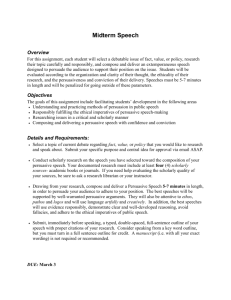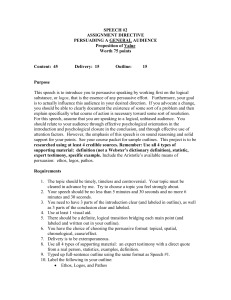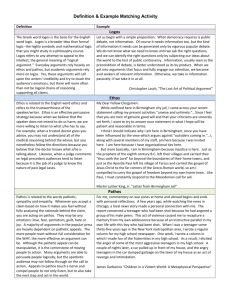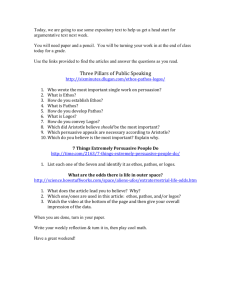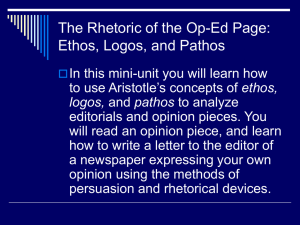Persuasive Speech
advertisement
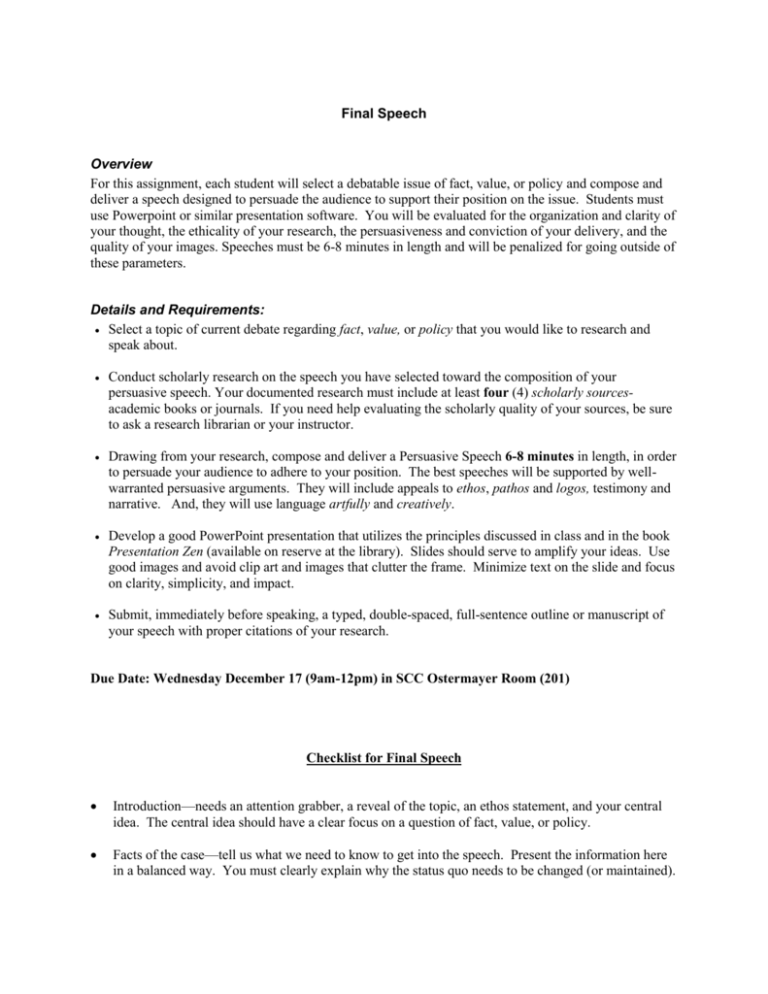
Final Speech Overview For this assignment, each student will select a debatable issue of fact, value, or policy and compose and deliver a speech designed to persuade the audience to support their position on the issue. Students must use Powerpoint or similar presentation software. You will be evaluated for the organization and clarity of your thought, the ethicality of your research, the persuasiveness and conviction of your delivery, and the quality of your images. Speeches must be 6-8 minutes in length and will be penalized for going outside of these parameters. Details and Requirements: Select a topic of current debate regarding fact, value, or policy that you would like to research and speak about. Conduct scholarly research on the speech you have selected toward the composition of your persuasive speech. Your documented research must include at least four (4) scholarly sourcesacademic books or journals. If you need help evaluating the scholarly quality of your sources, be sure to ask a research librarian or your instructor. Drawing from your research, compose and deliver a Persuasive Speech 6-8 minutes in length, in order to persuade your audience to adhere to your position. The best speeches will be supported by wellwarranted persuasive arguments. They will include appeals to ethos, pathos and logos, testimony and narrative. And, they will use language artfully and creatively. Develop a good PowerPoint presentation that utilizes the principles discussed in class and in the book Presentation Zen (available on reserve at the library). Slides should serve to amplify your ideas. Use good images and avoid clip art and images that clutter the frame. Minimize text on the slide and focus on clarity, simplicity, and impact. Submit, immediately before speaking, a typed, double-spaced, full-sentence outline or manuscript of your speech with proper citations of your research. Due Date: Wednesday December 17 (9am-12pm) in SCC Ostermayer Room (201) Checklist for Final Speech Introduction—needs an attention grabber, a reveal of the topic, an ethos statement, and your central idea. The central idea should have a clear focus on a question of fact, value, or policy. Facts of the case—tell us what we need to know to get into the speech. Present the information here in a balanced way. You must clearly explain why the status quo needs to be changed (or maintained). Main points—phrase each as a mini-thesis statement and/or specific arguments. Do they, in sum, provide strong grounds for the judgment you want the audience to make? Support— draw from five areas of support (ethos, pathos, logos, external testimony or data, narrative life). Select and arrange these with care. o Ethos—in the intro and throughout, you need to establish yourself as balanced, a good judge, and one who has the audience’s best interests in mind. o Pathos—place your audience in moods and cultivate emotional responses to your words (fear, hope, pity, anger, envy, friendship, courage). o Logos—Argument- use the "means of persuasion" sheet to develop a diversity of arguments (arguments by definition, similarity, difference, degree, cause/effect, etc.) Make sure your arguments collectively have a diversity of warrants. o Testimony—make sure your sources are strong and your arguments are grounded in credible testimony. When quoting, first tell us the writer’s name and affiliation. o Narrative life— make sure each point has moments that make it come alive through sensory detail, narration, example, analogy. Counter argument— consider and refute the opposition's best arguments. You can demonstrate your balance and good judgment by accepting that their concerns are legitimate but that you have a better way to address them. Transitions/arrangement— make sure the main points are well ordered and linked and that they build to a kind of climax. Where should your best arguments or ideas be placed? Conclusion— needs to signal the end of the speech, reiterate the main points, amplify and extend the significance, and leave us with something memorable. This is also a good place to call us to action Significance—does your speech matter? Is the end or goal of the speech one that the audience can willingly accept? Does it entail any ethical problems or other issues that, if examined, would make the speech seem less acceptable? Slides: o o o o Choose fonts and backgrounds wisely. Strive for simplicity and clarity. Embrace empty space. Consider the rule of thirds. Minimize text on the slide. Consider a handout if your speech has a lot of data to report. Images should amplify your words. Avoid clip art, animation, complex charts, clutter. Consider some examples: http://www.slideshare.net/garr/sample-slides-by-garr-reynolds, http://www.ted.com/talks/candy_chang_before_i_die_i_want_to.html, http://www.ted.com/talks/marcin_jakubowski.html, http://www.ted.com/talks/david_byrne_how_architecture_helped_music_evolve.html
